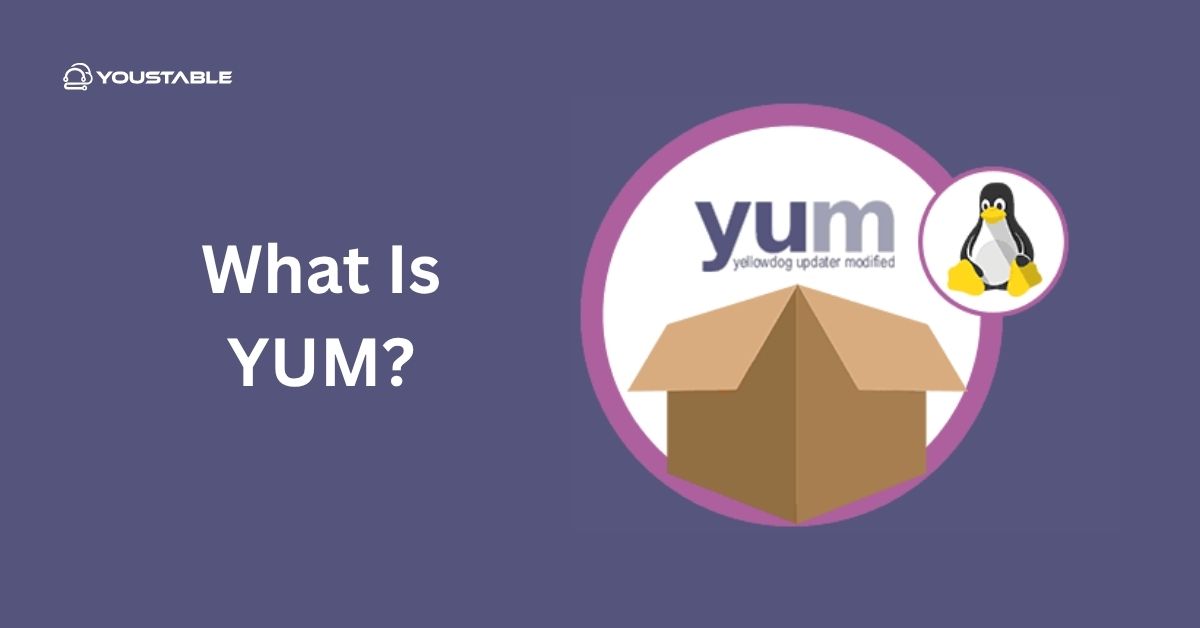If you want to understand YUM on a Linux server, this guide covers how YUM works, why it’s important, how it compares to other package tools, real-world usage, and clear answers to the most common questions. YUM is an essential piece of the Linux ecosystem for anyone managing packages on Red Hat-based distributions.
What Is YUM?

YUM (Yellowdog Updater, Modified) is a command-line utility for managing, installing, updating, and removing software packages on RPM-based Linux systems such as CentOS, Red Hat Enterprise Linux, and older versions of Fedora.
YUM automates software management by resolving dependencies, retrieving packages from software repositories, and keeping systems up to date. In newer versions of Red Hat and Fedora, DNF (“Dandified YUM”) has largely replaced it, but YUM commands remain widely supported for compatibility and familiarity.
How Does YUM Work?
YUM uses software repositories—directories or collections of packages managed on local or remote servers. Each package is a standardized archive (.rpm) containing the software and metadata, such as version, dependencies, and digital signatures.
When you issue a YUM command, the tool:
- Searches repositories for packages matching your requirements.
- Resolves dependencies automatically (installs all supporting packages necessary for the main application).
- Downloads and installs (or removes or updates) these packages.
- Verifies integrity using GPG signatures if enabled.
Unlike RPM (the underlying package manager), YUM completely automates dependency management, making complex installations and upgrades much simpler.
Why Use YUM on Linux Servers?
YUM (Yellowdog Updater, Modified) is a powerful command-line package manager for RPM-based Linux distributions like CentOS, RHEL, and AlmaLinux. It streamlines software management, system updates, and automation. Here’s why it’s essential for server administrators:
- Simplified Management: Install, update, remove, and list packages with a single tool and consistent commands.
- Automatic Updates: Keep your system secure and up to date with minimal manual work.
- Dependency Handling: No manual tracking of package requirements—YUM resolves and installs them for you.
- Repository Control: Easily enable, disable, or add additional repositories for more software options.
- Scripting & Automation: Integrate YUM commands into shell scripts or cron jobs to automate server maintenance.
- Security Integration: Supports GPG signature verification for trusted, authenticated updates.
Check Out | Install YUM on Linux Server: Quick and Easy Setup Guide
Understand YUM Common Tasks and Commands
| Task | Command Example |
|---|---|
| Install a package | yum install httpd |
| Remove a package | yum remove httpd |
| Update installed packages | yum update |
| Search for a package | yum search nginx |
| Display info about a package | yum info openssl |
| List all installed packages | yum list installed |
| Clean package cache | yum clean all |
| Enable/disable repository (single action) | yum --enablerepo=repoid update |
| Make local metadata cache | yum makecache |
Note: Most operations require superuser privileges. Prefix commands with sudo as needed.
YUM vs. Other Linux Package Managers
| Feature | YUM (RPM-Based) | APT (Debian-Based) | DNF (Modern RPM-Based) |
|---|---|---|---|
| Package type | .rpm | .deb | .rpm |
| Dependency mgmt | Automatic | Automatic | Automatic, more advanced |
| Repositories | Easy config, local/remote | Easy config, local/remote | Improved, supports plugins |
| Speed | Moderate | Fast | Faster than YUM |
| Default on | RHEL, CentOS, Oracle | Ubuntu, Debian | Fedora 22+, RHEL 8+ |
YUM in Linux Server Environments
YUM is particularly valuable in server environments where reliability, automation, and consistency matter. It’s commonly used for:
- Installing and updating web servers (Apache, NGINX), databases (MySQL, PostgreSQL), programming tools, and more.
- Automating security and feature updates via scheduled jobs.
- Maintaining consistency across multiple servers using repository management.
- Setting up local repositories in corporate or offline environments.
Frequently Asked Questions (FAQs)
What is YUM, and how does it simplify package management on Linux servers?
YUM is a command-line tool that handles installation, removal, and updating of software on RPM-based Linux systems. Its key benefit is automatic dependency resolution: simply specify what you want to install or remove, and YUM takes care of finding, resolving, and managing all necessary packages from trusted repositories. This saves administrators significant time and reduces errors compared to manual management.
Is YUM still used, or should I switch to DNF?
While YUM remains available for compatibility (especially on RHEL/CentOS 7 and earlier), DNF has replaced YUM as the default in recent Fedora and RHEL versions. DNF brings better performance and dependency handling, but offers a very similar command-line experience. For modern systems, especially RHEL 8 and Fedora 22+, use DNF; on older systems, YUM is still appropriate and reliable.
How do I resolve problems if a YUM operation fails or a package breaks dependencies?
First, check for typos or conflicts and review the specific error message. Use yum clean all it to clear the cache, then try again. For dependency issues, YUM typically reports which packages are causing trouble so you can update, remove, or install them as needed. In stubborn cases, consider using yum history to undo recent changes, or check the repository and network configurations.
Conclusion
To understand YUM on a Linux server is to master a key tool for software installation, updates, and maintenance. YUM’s automatic dependency resolution, easy repository management, consistent syntax, and integration with system automation make it a cornerstone of any RPM-based Linux environment. By learning YUM, you ensure your server remains up to date, secure, and flexible for any workload.


